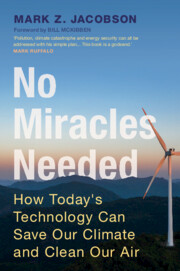Book contents
- No Miracles Needed
- Reviews
- No Miracles Needed
- Copyright page
- Dedication
- Contents
- Figures
- Foreword
- Preface
- 1 What Problems Are We Trying to Solve?
- 2 WWS Solutions for Electricity Generation
- 3 WWS Solutions for Electricity Storage
- 4 WWS Solutions for Transportation
- 5 WWS Solutions for Buildings
- 6 WWS Solutions for Industry
- 7 Solutions for Nonenergy Emissions
- 8 What Doesn’t Work
- 9 Electricity Grids
- 10 Photovoltaics and Solar Radiation
- 11 Onshore and Offshore Wind Energy
- 12 Steps in Developing 100 Percent WWS Roadmaps
- 13 Keeping the Grid Stable with 100 Percent WWS
- 14 Timeline and Policies Needed to Transition
- 15 My Journey
- References
- Index
10 - Photovoltaics and Solar Radiation
Published online by Cambridge University Press: 02 February 2023
- No Miracles Needed
- Reviews
- No Miracles Needed
- Copyright page
- Dedication
- Contents
- Figures
- Foreword
- Preface
- 1 What Problems Are We Trying to Solve?
- 2 WWS Solutions for Electricity Generation
- 3 WWS Solutions for Electricity Storage
- 4 WWS Solutions for Transportation
- 5 WWS Solutions for Buildings
- 6 WWS Solutions for Industry
- 7 Solutions for Nonenergy Emissions
- 8 What Doesn’t Work
- 9 Electricity Grids
- 10 Photovoltaics and Solar Radiation
- 11 Onshore and Offshore Wind Energy
- 12 Steps in Developing 100 Percent WWS Roadmaps
- 13 Keeping the Grid Stable with 100 Percent WWS
- 14 Timeline and Policies Needed to Transition
- 15 My Journey
- References
- Index
Summary
Solar and wind will make up the bulk of a 100 percent WWS energy generation infrastructure worldwide. The main types of solar generation are from photovoltaics (PV) on rooftops and in utility-scale power plants, concentrated solar power (CSP) plants, and solar thermal collectors for water heating. The sun produces enough energy worldwide to power the world with PV for all purposes in 2050 about 2,200 times over if all energy were electrified. Over land, PV can power all energy about 640 times over. Needless to say, the world needs only a small portion of this. For example, if half of the world’s all-purpose power were from solar PV, only about 0.08 percent of the world’s solar resource over land would be needed. Given the large potential of solar PV in particular for powering all energy needs, it is useful to understand PV panels and solar resources better. This chapter discusses both. The chapter starts with a detailed description of solar PV cells, panels, and arrays and their efficiencies. It also discusses solar resource availability and optimal tilt angles for solar panels worldwide.
- Type
- Chapter
- Information
- No Miracles NeededHow Today's Technology Can Save Our Climate and Clean Our Air, pp. 214 - 232Publisher: Cambridge University PressPrint publication year: 2023



